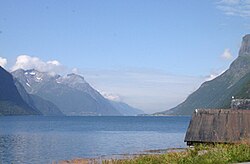Hjørundfjord
Hjørundfjord Municipality
Hjørundfjord herred | |
|---|---|
 View of the Hjørundfjorden from the south (in from the section called Storfjorden by Viddal) | |
 Møre og Romsdal within Norway | |
 Hjørundfjord within Møre og Romsdal | |
| Coordinates: 62°12′33″N 06°28′11″E / 62.20917°N 6.46972°E | |
| Country | Norway |
| County | Møre og Romsdal |
| District | Sunnmøre |
| Established | 1 Jan 1838 |
| • Created as | Formannskapsdistrikt |
| Disestablished | 1 Jan 1964 |
| • Succeeded by | Ørsta Municipality |
| Administrative centre | Sæbø |
| Area (upon dissolution) | |
| • Total | 277 km2 (107 sq mi) |
| Population (1964) | |
| • Total | 1,728 |
| • Density | 6.2/km2 (16/sq mi) |
| Demonym | Hjørundfjording[1] |
| Time zone | UTC+01:00 (CET) |
| • Summer (DST) | UTC+02:00 (CEST) |
| ISO 3166 code | NO-1522[2] |
Hjørundfjord is a former municipality in Møre og Romsdal county, Norway. The municipality existed from 1838 until its dissolution in 1964. The 277-square-kilometre (107 sq mi) municipality is now a part of the municipality of Ørsta. The administrative centre was the village of Sæbø, located on the shores of the Hjørundfjorden. The municipality encircled both sides of the Hjørundfjorden as well as the Bondalen valley. The villages of Bjørke, Leira, and Store Standal were all a part Hjørundfjord Municipality.[3]
History
The municipality was established on 1 January 1838 (see formannskapsdistrikt law). The original municipality was the same as the prestegjeld (parish) of Hjørundfjord. During the 1960s, there were many municipal mergers across Norway due to the work of the Schei Committee. On 1 January 1964, the three neighboring municipalities of Hjørundfjord (population: 1,728), Vartdal (population: 1,315), and Ørsta (population: 6,209) were merged into one large municipality, under the name Ørsta.[4]
Government
All municipalities in Norway, including Hjørundfjord, are responsible for primary education (through 10th grade), outpatient health services, senior citizen services, unemployment and other social services, zoning, economic development, and municipal roads. The municipality is governed by a municipal council of elected representatives, which in turn elects a mayor.[5]
Municipal council
The municipal council (Heradsstyre) of Hjørundfjord was made up of 17 representatives that were elected to four year terms. The party breakdown of the final municipal council was as follows:
| Party name (in Nynorsk) | Number of representatives | |
|---|---|---|
| Labour Party (Arbeidarpartiet) | 2 | |
| Local List(s) (Lokale lister) | 15 | |
| Total number of members: | 17 | |
| Party name (in Nynorsk) | Number of representatives | |
|---|---|---|
| Labour Party (Arbeidarpartiet) | 2 | |
| Local List(s) (Lokale lister) | 15 | |
| Total number of members: | 17 | |
| Party name (in Nynorsk) | Number of representatives | |
|---|---|---|
| Labour Party (Arbeidarpartiet) | 2 | |
| Local List(s) (Lokale lister) | 14 | |
| Total number of members: | 16 | |
| Party name (in Nynorsk) | Number of representatives | |
|---|---|---|
| Local List(s) (Lokale lister) | 16 | |
| Total number of members: | 16 | |
| Party name (in Nynorsk) | Number of representatives | |
|---|---|---|
| List of workers, fishermen, and small farmholders (Arbeidarar, fiskarar, småbrukarar liste) | 2 | |
| Local List(s) (Lokale lister) | 14 | |
| Total number of members: | 16 | |
| Party name (in Nynorsk) | Number of representatives | |
|---|---|---|
| Labour Party (Arbeidarpartiet) | 2 | |
| Local List(s) (Lokale lister) | 14 | |
| Total number of members: | 16 | |
| Note: Due to the German occupation of Norway during World War II, no elections were held for new municipal councils until after the war ended in 1945. | ||
Notable residents
- Knut Skram (born 1937), baritone
- Rasmus Skylstad (1893–1972), diplomat
See also
References
- ^ "Navn på steder og personer: Innbyggjarnamn" (in Norwegian). Språkrådet.
- ^ Bolstad, Erik; Thorsnæs, Geir, eds. (2023-01-26). "Kommunenummer". Store norske leksikon (in Norwegian). Kunnskapsforlaget.
- ^ Thorsnæs, Geir, ed. (2015-09-13). "Hjørundfjord - tidligere kommune i Møre og Romsdal". Store norske leksikon (in Norwegian). Kunnskapsforlaget. Retrieved 2019-08-24.
- ^ Jukvam, Dag (1999). "Historisk oversikt over endringer i kommune- og fylkesinndelingen" (PDF) (in Norwegian). Statistisk sentralbyrå.
- ^ Hansen, Tore, ed. (2016-05-12). "kommunestyre". Store norske leksikon (in Norwegian). Kunnskapsforlaget. Retrieved 2020-02-02.
- ^ "Kommunevalgene og Ordførervalgene 1959" (PDF) (in Norwegian). Oslo: Statistisk sentralbyrå. 1960. Retrieved 2020-04-20.
- ^ "Kommunevalgene og Ordførervalgene 1955" (PDF) (in Norwegian). Oslo: Statistisk sentralbyrå. 1957. Retrieved 2020-04-20.
- ^ "Kommunevalgene og Ordførervalgene 1951" (PDF) (in Norwegian). Oslo: Statistisk sentralbyrå. 1952. Retrieved 2020-04-20.
- ^ "Kommunevalgene og Ordførervalgene 1947" (PDF) (in Norwegian). Oslo: Statistisk sentralbyrå. 1948. Retrieved 2020-04-20.
- ^ "Kommunevalgene og Ordførervalgene 1945" (PDF) (in Norwegian). Oslo: Statistisk sentralbyrå. 1947. Retrieved 2020-04-20.
- ^ "Kommunevalgene og Ordførervalgene 1937" (PDF) (in Norwegian). Oslo: Statistisk sentralbyrå. 1938. Retrieved 2020-04-20.
External links
 The dictionary definition of Hjørundfjord at Wiktionary
The dictionary definition of Hjørundfjord at Wiktionary Hjørundfjord travel guide from Wikivoyage
Hjørundfjord travel guide from Wikivoyage- Official website about Hjørundfjorden (in Norwegian)

